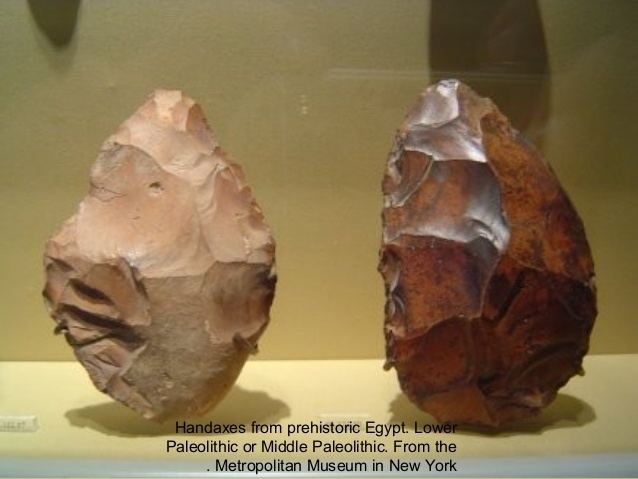 | ||
Prehistoric egypt before the pharaohs
The prehistory of Egypt spans the period from earliest human settlement to the beginning of the Early Dynastic Period of Egypt around c. 3100 BC, starting with the first Pharaoh, Narmer for some egyptologists, Aha for others, (also known as Menes). This Predynastic era is traditionally equivalent to the final part of the Neolithic period beginning c. 6000 BC and corresponds to the Naqada III period.
Contents
- Prehistoric egypt before the pharaohs
- Late Paleolithic
- Wadi Halfa
- Aterian Industry
- Khormusan Industry
- Halfan culture
- Qadan and Sebilian cultures
- Harifian culture
- Faiyum A culture
- Merimde culture
- El Omari culture
- Maadi culture
- Tasian culture
- Badarian culture
- Naqada culture
- Timeline
- References

The dates of the Predynastic period were first defined before widespread archaeological excavation of Egypt took place, and recent finds indicating very gradual Predynastic development have led to controversy over when exactly the Predynastic period ended. Thus, the term "Protodynastic period", sometimes called the "Zero Dynasty", has been used by scholars to name the part of the period which might be characterized as Predynastic by some and Early Dynastic by others.
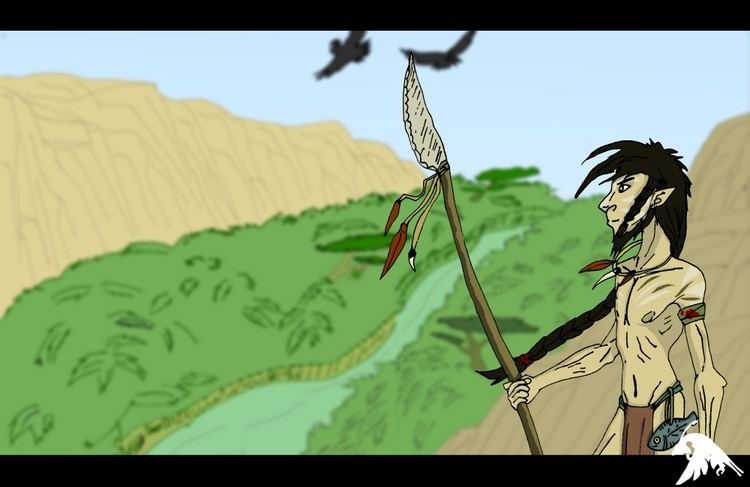
The Predynastic period is generally divided into cultural periods, each named after the place where a certain type of Egyptian settlement was first discovered. However, the same gradual development that characterizes the Protodynastic period is present throughout the entire Predynastic period, and individual "cultures" must not be interpreted as separate entities but as largely subjective divisions used to facilitate study of the entire period.

The vast majority of Predynastic archaeological finds have been in Upper Egypt, because the silt of the Nile River was more heavily deposited at the Delta region, completely burying most Delta sites long before modern times.
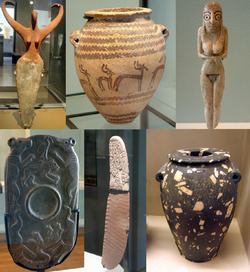
Late Paleolithic
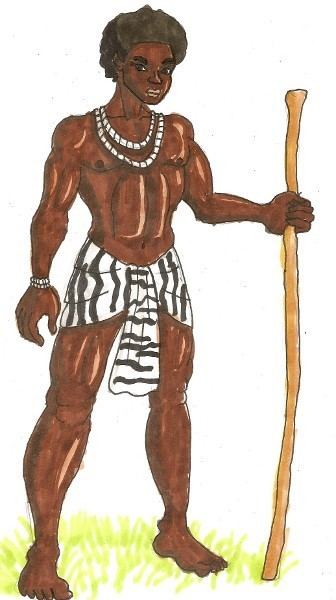
The Late Paleolithic in Egypt started around 30,000 BC. The Nazlet Khater skeleton was found in 1980 and dated in 1982 from nine samples ranging between 35,100 and 30,360 years. This specimen is the only complete modern human skeleton from the earliest Late Stone Age in Africa.
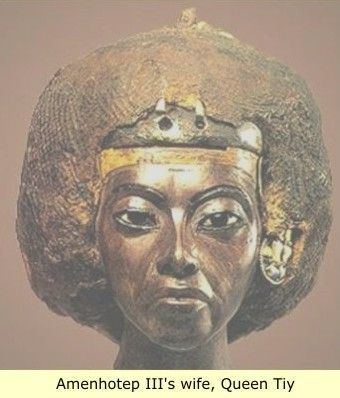
Excavation of the Nile has exposed early stone tools. The earliest of these lithic industries were located within the 100-foot terrace, and were Chellean, primitive Acheulean and an Egyptian form of the Clactonian. Within the 50-foot terrace was developed Acheulean. Originally reported as Early Mousterian but since changed to Levalloisean, other implements were located in the 30-foot terrace. The 15- and 10-foot terraces saw a more developed version of the Levalloisean, also initially reported as an Egyptian version of Mousterian. Finally, tools of the Egyptian Sebilian technology and an Egyptian version of the Aterian technology were also located.
Wadi Halfa
Some of the oldest known buildings were discovered in Egypt by archaeologist Waldemar Chmielewski along the southern border near Wadi Halfa. They were mobile structures—easily disassembled, moved, and reassembled—providing hunter-gatherers with semi-permanent habitation.
Aterian Industry
Aterian tool-making reached Egypt c. 40,000 BC.
Khormusan Industry
The Khormusan industry in Egypt began between 40,000 and 30,000 BC. Khormusans developed advanced tools not only from stone but also from animal bones and hematite. They also developed small arrow heads resembling those of Native Americans, but no bows have been found. The end of the Khormusan industry came around 16,000 B.C. with the appearance of other cultures in the region, including the Gemaian.
Halfan culture
The Halfan culture flourished along the Nile Valley of Egypt and Nubia between 18,000 and 15,000 BC, though one Halfan site dates to before 24,000 BC. People survived on a diet of large herd animals and the Khormusan tradition of fishing. Greater concentrations of artifacts indicate that they were not bound to seasonal wandering, but settled for longer periods. They are viewed as the parent culture of the Ibero-Maurusian industry, which spread across the Sahara and into Spain. The Halfan culture was derived in turn from the Khormusan, which depended on specialized hunting, fishing, and collecting techniques for survival. The primary material remains of this culture are stone tools, flakes, and a multitude of rock paintings.
Qadan and Sebilian cultures
About twenty archaeological sites in upper Nubia give evidence for the existence of a grain-grinding Mesolithic culture called the Qadan Culture, which practiced wild grain harvesting along the Nile during the beginning of the Sahaba Daru Nile phase, when desiccation in the Sahara caused residents of the Libyan oases to retreat into the Nile valley.
Qadan peoples developed sickles and grinding stones to aid in the collecting and processing of these plant foods prior to consumption. However, there are no indications of the use of these tools after around 10,000 BC, when hunter-gatherers replaced them.
In Egypt, analyses of pollen found at archaeological sites indicate that the Sebilian culture (also known as the Esna culture) were gathering wheat and barley. Domesticated seeds were not found (modern wheat and barley originated in Asia Minor and Canaan). It has been hypothesized that the sedentary lifestyle used by farmers led to increased warfare, which was detrimental to farming and brought this period to an end.
Harifian culture
The Harifians are viewed as migrating out of the Fayyum and the Eastern Deserts of Egypt during the late Mesolithic to merge with the Pre-Pottery Neolithic B (PPNB) culture, whose tool assemblage resembles that of the Harifian. This assimilation led to the Circum-Arabian Nomadic Pastoral Complex, a group of cultures that invented nomadic pastoralism, and may have been the original culture which spread Proto-Semitic languages throughout Mesopotamia.
Faiyum A culture
Continued expansion of the desert forced the early ancestors of the Egyptians to settle around the Nile more permanently and adopt a more sedentary lifestyle.
The period from 9000 to 6000 BC has left very little in the way of archaeological evidence. Around 6000 BC, Neolithic settlements appear all over Egypt. Studies based on morphological, genetic, and archaeological data have attributed these settlements to migrants from the Fertile Crescent in the Near East returning during the Egyptian and North African Neolithic, bringing agriculture to the region. However, other regions in Africa independently developed agriculture at about the same time: the Ethiopian highlands, the Sahel, and West Africa.
Some morphological and post-cranial data has linked the earliest farming populations at Fayum, Merimde, and El-Badari, to Near Eastern populations. However, the archaeological data also suggests that Near Eastern domesticates were incorporated into a pre-existing foraging strategy and only slowly developed into a full-blown lifestyle, contrary to what would be expected from settler colonists from the Near East. Finally, the names for the Near Eastern domesticates imported into Egypt were not Sumerian or Proto-Semitic loan words, which further diminishes the likelihood of a mass immigrant colonization of lower Egypt during the transition to agriculture.
Weaving is evidenced for the first time during the Faiyum A Period. People of this period, unlike later Egyptians, buried their dead very close to, and sometimes inside, their settlements.
Although archaeological sites reveal very little about this time, an examination of the many Egyptian words for "city" provide a hypothetical list of reasons why the Egyptians settled. In Upper Egypt, terminology indicates trade, protection of livestock, high ground for flood refuge, and sacred sites for deities.
Merimde culture
From about 5000 to 4200 BC the Merimde culture, so far only known from a big settlement site at the edge of the Western Delta, flourished in Lower Egypt. The culture has strong connections to the Faiyum A culture as well as the Levant. People lived in small huts, produced a simple undecorated pottery and had stone tools. Cattle, sheep, goats and pigs were held. Wheat, sorghum and barley were planted. The Merimde people buried their dead within the settlement and produced clay figurines. The first Egyptian lifesize head made of clay comes from Merimde.
El Omari culture
The El Omari culture is known from a small settlement near modern Cairo. People seem to have lived in huts, but only postholes and pits survive. The pottery is undecorated. Stone tools include small flakes, axes and sickles. Metal was not yet known. Their sites were occupied from 4000 BC to the Archaic Period.
Maadi culture
The Maadi culture (also called Buto Maadi culture) is the most important Lower Egyptian prehistoric culture contemporary with Naqada I and II phases in Upper Egypt. The culture is best known from the site Maadi near Cairo, but is also attested in many other places in the Delta to the Fayum region.
Copper was known, and some copper adzes have been found. The pottery is simple and undecorated and shows, in some forms, strong connections to Southern Israel. People lived in small huts, partly dug into the ground. The dead were buried in cemeteries, but with few burial goods. The Maadi culture was replaced by the Naqada III culture; whether this happened by conquest or infiltration is still an open question.
Tasian culture
The Tasian culture was the next in Upper Egypt. This culture group is named for the burials found at Der Tasa, on the east bank of the Nile between Asyut and Akhmim. The Tasian culture group is notable for producing the earliest blacktop-ware, a type of red and brown pottery that is painted black on the top and interior. This pottery is vital to the dating of Predynastic Egypt. Because all dates for the Predynastic period are tenuous at best, WMF Petrie developed a system called Sequence Dating by which the relative date, if not the absolute date, of any given Predynastic site can be ascertained by examining its pottery.
As the Predynastic period progressed, the handles on pottery evolved from functional to ornamental. The degree to which any given archaeological site has functional or ornamental pottery can also be used to determine the relative date of the site. Since there is little difference between Tasian ceramics and Badarian pottery, the Tasian Culture overlaps the Badarian range significantly. From the Tasian period onward, it appears that Upper Egypt was influenced strongly by the culture of Lower Egypt.
Badarian culture
The Badarian culture, from about 4400 to 4000 BC, is named for the Badari site near Der Tasa. It followed the Tasian culture, but was so similar that many consider them one continuous period. The Badarian Culture continued to produce the kind of pottery called Blacktop-ware (albeit much improved in quality) and was assigned Sequence Dating numbers 21 - 29. The primary difference that prevents scholars from merging the two periods is that Badarian sites use copper in addition to stone and are thus chalcolithic settlements, while the Neolithic Tasian sites are still considered Stone Age.
Badarian flint tools continued to develop into sharper and more shapely blades, and the first faience was developed. Distinctly Badarian sites have been located from Nekhen to a little north of Abydos. It appears that the Fayum A culture and the Badarian and Tasian Periods overlapped significantly; however, the Fayum A culture was considerably less agricultural and was still Neolithic in nature.
Naqada culture
Amratian culture (Naqada I)
The Amratian culture lasted from about 4000 to 3500 BC. It is named after the site of El-Amra, about 120 km south of Badari. El-Amra is the first site where this culture group was found unmingled with the later Gerzean culture group, but this period is better attested at the Naqada site, so it also is referred to as the Naqada I culture. Black-topped ware continues to appear, but white cross-line ware, a type of pottery which has been decorated with close parallel white lines being crossed by another set of close parallel white lines, is also found at this time. The Amratian period falls between S.D. 30 and 39 in Petrie's Sequence Dating system.
Newly excavated objects attest to increased trade between Upper and Lower Egypt at this time. A stone vase from the north was found at el-Amra, and copper, which is not mined in Egypt, was imported from the Sinai, or possibly Nubia. Obsidian and a small amount of gold were both definitely imported from Nubia. Trade with the oases also was likely.
New innovations appeared in Amratian settlements as precursors to later cultural periods. For example, the mud-brick buildings for which the Gerzean period is known were first seen in Amratian times, but only in small numbers. Additionally, oval and theriomorphic cosmetic palettes appear in this period, but the workmanship is very rudimentary and the relief artwork for which they were later known is not yet present.
Gerzean culture (Naqada II)
The Gerzean culture, from about 3500 to 3200 BC, is named after the site of Gerzeh. It was the next stage in Egyptian cultural development, and it was during this time that the foundation of Dynastic Egypt was laid. Gerzean culture is largely an unbroken development out of Amratian Culture, starting in the delta and moving south through upper Egypt, but failing to dislodge Amratian culture in Nubia. Gerzean pottery is assigned values from S.D. 40 through 62, and is distinctly different from Amratian white cross-lined wares or black-topped ware. Gerzean pottery was painted mostly in dark red with pictures of animals, people, and ships, as well as geometric symbols that appear derived from animals. Also, "wavy" handles, rare before this period (though occasionally found as early as S.D. 35) became more common and more elaborate until they were almost completely ornamental.
Gerzean culture coincided with a significant decline in rainfall, and farming along the Nile now produced the vast majority of food, though contemporary paintings indicate that hunting was not entirely forgone. With increased food supplies, Egyptians adopted a much more sedentary lifestyle and cities grew as large as 5,000.
It was in this time that Egyptian city dwellers stopped building with reeds and began mass-producing mud bricks, first found in the Amratian Period, to build their cities.
Egyptian stone tools, while still in use, moved from bifacial construction to ripple-flaked construction. Copper was used for all kinds of tools, and the first copper weaponry appears here. Silver, gold, lapis, and faience were used ornamentally, and the grinding palettes used for eye-paint since the Badarian period began to be adorned with relief carvings.
The first tombs in classic Egyptian style were also built, modeled after ordinary houses and sometimes composed of multiple rooms. Although further excavations in the Delta are needed, this style is generally believed to originate there and not in Upper Egypt.
Although the Gerzean Culture is now clearly identified as being the continuation of the Amratian period, significant amounts of Mesopotamian influences worked their way into Egypt during the Gerzean which were interpreted in previous years as evidence of a Mesopotamian ruling class, the so-called Dynastic Race, coming to power over Upper Egypt. This idea no longer attracts academic support.
Distinctly foreign objects and art forms entered Egypt during this period, indicating contacts with several parts of Asia. Objects such as the Gebel el-Arak knife handle, which has patently Mesopotamian relief carvings on it, have been found in Egypt, and the silver which appears in this period can only have been obtained from Asia Minor.
In addition, Egyptian objects are created which clearly mimic Mesopotamian forms, although not slavishly. Cylinder seals appear in Egypt, as well as recessed paneling architecture, the Egyptian reliefs on cosmetic palettes are clearly made in the same style as the contemporary Mesopotamian Uruk culture, and the ceremonial mace heads which turn up from the late Gerzean and early Semainean are crafted in the Mesopotamian "pear-shaped" style, instead of the Egyptian native style.
The route of this trade is difficult to determine, but contact with Canaan does not predate the early dynastic, so it is usually assumed to have been by water. During the time when the Dynastic Race Theory was still popular, it was theorized that Uruk sailors circumnavigated Arabia, but a Mediterranean route, probably by middlemen through Byblos is more likely, as evidenced by the presence of Byblian objects in Egypt.
The fact that so many Gerzean sites are at the mouths of wadis which lead to the Red Sea may indicate some amount of trade via the Red Sea (though Byblian trade potentially could have crossed the Sinai and then taken to the Red Sea). Also, it is considered unlikely that something as complicated as recessed panel architecture could have worked its way into Egypt by proxy, and at least a small contingent of migrants is often suspected.
Despite this evidence of foreign influence, Egyptologists generally agree that the Gerzean Culture is still predominantly indigenous to Egypt.
Protodynastic Period (Naqada III)
The Naqada III period, from about 3200 to 3000 BC, is generally taken to be identical with the Protodynastic period, during which Egypt was unified.
Naqada III is notable for being the first era with hieroglyphs (though this is disputed by some), the first regular use of serekhs, the first irrigation, and the first appearance of royal cemeteries.
The relatively affluent Maadi suburb of Cairo is built over the original Naqada stronghold.
